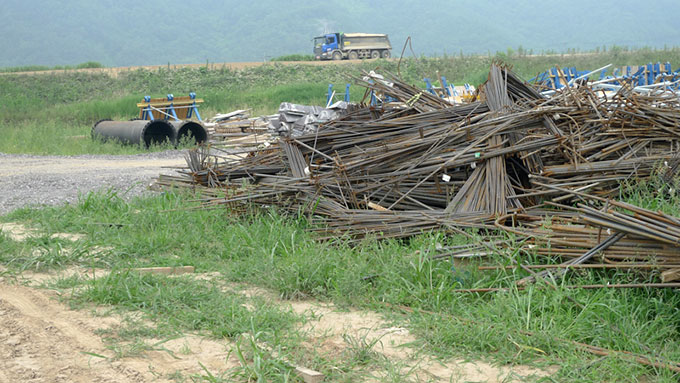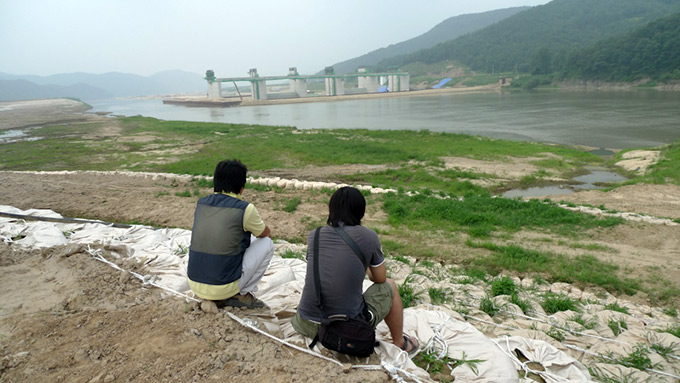A Personal View
Two weeks ago, I was cordially invited to attend the 2nd Korea-Japan Joint Civil Investigation of the Four Rivers Project. This event was hosted by the Korean Wetlands NGO Network (KWNN) and RAMSAR Network Japan (RamNet Japan). My schedule only allowed me to attend on Saturday, July 10, but of course I was excited and jumped at this chance. I was interested in listening to and learning the perspectives of the participants in attendance. These participants included members and representatives of some of Korea's NGO's and academics, as well as representatives from RamNet Japan, a few environmental lawyers, activists, and Japanese academics. Three Birds Koreans participated, including the National Coordinator Ms. Park Meena and myself, along with Ms. Lee Jeonga who took several photographs of the day. We accompanied the International Coordinator of KWNN, Mrs. Sunny Harrison. We arrived in Daegu from Busan just in time to follow the group’s tour bus to the first site we planned to observe, Hapcheon Bo. Bo translates in Korean to weir, also known as a low head dam, which in this case, is not the case. Hapcheon Bo is located in South Gyeongsang Province along the Nakdong River.
As we drove, light-hearted conversation in Korean was flowing and I would listen in closely, sometimes catching some laughter and bits and pieces of the language that I understood. The atmosphere was playful yet professional, and honestly I felt very well-accepted. I would drift in and out of conversations, when not speaking, imagining to myself possibilities the morning and afternoon could unfold. As my eyes gazed in and out of focus, I took notice of a heavy dump truck sweeping by, and then another, and then of course, another. They were full and trails of red dust followed them. They were going in the opposite direction to us. The laughter was gone inside, and our party became silent.
We pulled up behind the bus on the side of the road, and one by one we stepped out. I was introduced to a few people but even then I couldn't really smile. I looked out and saw nothing but remains. There were patches of heavy machinery spread out across what seemed to be a half-naked beaten piece of land. I could only imagine how beautiful it must have been before, but now transformed. The roads were much like those you'd expect at a construction site, dump trucks endlessly coming and going. They were like ants, only giant and lifeless. Every time one roared by, I wondered to myself how the driver must have felt as he passed me walking along the dirt road. Small hills of sand, some with grass cover; some without, buried an area that perhaps was once a naturally robust rice paddy. The participants slowly walked down the dirt road towards the river, everyone at their own pace, observing mostly in silence. I couldn't help but notice one of the freshly grown patches of grass. It was almost dreamlike. There were hundreds, maybe thousands, of small white butterflies fluttering about. A few people reasoned out loud why they suspected so many could be found in such a dense area. Some photos were taken and we continued on. It was then that my stomach began to feel uneasy. The sound of excavators and passing dump trucks quickly summoned many questions within my mind. We walked up to a parked crane next to some piles of scrap metal and then I noticed the true of victim of this obvious big mess: the river. Most of what used to be, is being stripped away and dredged. As far as my eyes could see, the natural bank was gone. In its place were thousands of white sand bags making way for a deepened river bed. The participants slowly converged to the edge of the new bank, and the meeting began.

I learned a great deal about this area of the Nakdong. Culturally, it's of considerable significance. Hapcheong was once the site of a traditional ferry terminal as well as the birthplace of a theatrical performance art piece known as Goseong Ogwangdae, Goseong Five Mask Dance. This performance was proclaimed and maintained as an "Important Intangible Cultural Property," by the Cultural Heritage Administration. This particular art form is closely related to the natural and seasonal conditions of Hapcheon. According to folklore, this area was often flooded. On one occasion, a chest floated downstream. A fisherman recovered the chest and discovered five masks inside. And the story goes on. The point of mentioning this story was to tie in heritage to this area in hopes to return it to its pre-industrial condition while also proving that this area has a history of flooding that was once accepted as a very natural phenomenon by the surrounding inhabitants. It was mentioned that most neighbors to this area of the Nakdong understood the natural cycle of the floods and survived easily within the boundaries of them, growing crops that grow well in saturated soil, and moving outward when necessary. Now that there has been an embankment built, there is an even more increased chance of flooding along the river. This leads to another concern: orchards. Many farmers in the area make their living by growing orchards. These farmers use pesticides on their orchards when cultivating. So if flooded, the pesticides could cause water pollution. As a precautionary measure, all farming is now being prohibited along the four major rivers. Many seem concerned that this could result in a nation-wide agricultural recession. So it was suggested that it would be more beneficial to reintroduce traditional farming methods such as saturated soil crops as a method of “Green Growth,” rather than to continue this plan of dredging and "restoration." One of the said purposes of this river project is to decrease flooding, which in this case in particular, seems to be just the opposite.
At the river bank, there was so much said. The dialogue was continuous, as the translator tirelessly interpreted. A large marshland, larger than Upo Wetland, was bitterly mentioned. After building a dike, it apparently disappeared. There was speculation that the construction of an embankment here as a countermeasure against flooding could do the same to Upo, as it is an important part of the Nakdong River floodplain. As most know, Upo is a Ramsar wetland site, designated as a protected area. Upo is home to numerous threatened and rare species. A key investigator at the event was Dr. Imamoto Hirotake, a Professor Emeritus of Kyoto University. Having much experience dealing with river construction in particular, he explained that it was frightening to see how speedy the construction on the river had been proceeding. To him, this was unimaginable and he mentioned having doubt as to whether the Minister of Environment had even evaluated the environmental effects of this project in advance. As we listened, dump trucks rumbled by every few minutes. I felt as if I was in a movie, and it was meant to be comical. It was time to move on to our next site. Walking back to our vehicles, to continue on to the next site of investigation, I listened in on a short interview with the professor. He went on to talk about the structure of the weir. The size of Hapcheon Weir in comparison to most weirs is substantially taller and of greater size, standing at 9 meters high, 593 meters long. Most weirs in Japan are generally 1 to 2 meters in height, built for the purpose of agricultural use or water control. He seemed puzzled as to why such a large structure would be built if meant solely for water control. He couldn't understand why so much was being dredged and so many weirs were being built at once in order to prevent flooding, improve water quality, or secure water resources. He then went on to explain that he was convinced that the structure we observed would serve no other purpose than that of a canal building process.

Everyone seemed upset as we walked away. It was hard to see this river turning into something so unrecognizable at such a quick rate. On our walk back, someone mentioned to me that the day before, most investigators had visited Haepyeong Marsh. Hapyeoung Marsh, in Gumi, is an internationally known site as a stopover for several thousand Hooded and White-naped Cranes. Some cranes even winter here. It was designated as a wildlife protection area in 1998. Well, despite the area's status and even a sign that is still present, most of the wetland has been dredged and buried. There is only a small area still intact. Plans to build a large scale sports park are underway.
To lighten up the participants, we took a short detour to Upo. The organizers thought it would be nice to see something beautiful before we moved on to the other sites. Even here dump trucks from surrounding sites muscled their way down the chalky small back roads. We arrived at Upo and it was a lush with greenery. We all stepped out for a short walk and fresh air. The sound of summer was buzzing. Butterflies and other insects were hard at work. I walked alone; looking out over the wetland, wondering what it would be like if it was gone. I didn't want to imagine. On such a beautiful countryside, it's hard to wonder why anyone would feel the need to transform what naturally is so perfect. We soon moved on and visited another site and then later in the evening we finished up with a meeting discussing what we saw.
The impact of this trip on me was tremendous. I saw what I had so often read about and it became much more real. I now feel the need to tell everyone I come in contact with about the criticality of this situation. Wherever I live, I'm normally an active volunteer. In fact, I was working here in Korea to save enough to get started as a full-time volunteer elsewhere. I had plans to travel to places like India and Africa in order to take an active role there participating in much needed work. Yet after this experience, I realized even more that there is much to do here, in Korea itself. As a member of any community I have in lived in, I've always felt the need to take an active role in helping to maintain its conservation, beginning with my own education and action.
There are many people, some concerned citizens, others experts, together hard at work trying to offer those in charge of this development a more sensible alternative, especially in regards to this region's ecosystem. I would like to invite others to join us. This "restoration" project is deplorable, and we as a community must do our best to change its course.



